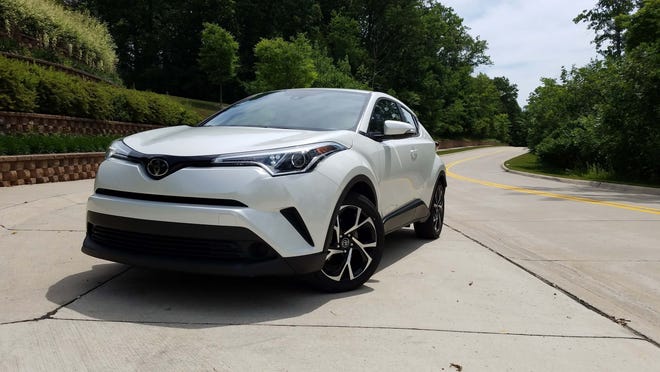Payne: Toyota C-HR a stormtrooper helmet on wheels
Concerned that everything is starting to look the same? Same suburban tract housing? Same workplace cubicles? Same ol’ five-door SUVs?

Good news, friends. The Toyota C-HR offers a little escapism.
It would appear that Toyota has moved its design studio to Hollywood, because this once-dowdy appliance-maker is turning out vehicles that belong in science-fiction films. First came Lexus with a spindle grille so fearsome it might have have been approved by Lord Darth Vader himself. Then Toyota stunned last fall’s LA Auto Show with its new C-HR compact crossover which appeared to have been shipped over from a Lucasfilm stage.

A white and black C-HR arrived in my driveway this summer looking like someone had grafted a “Star Wars” stormtrooper helmet on a “Tron” Light Cycle.
With its slit front headlights, huge wheels and “distinctive diamond” design philosophy, it shames big brother RAV-4’s conservative wardrobe. It deserves a place alongside the BMW i3 and Kia Soul for most funk-a-riffic vehicle. As the auto world splits between SUVs and sedans, these hatchbacks seek a third way: segment busters with a bold mix of ingredients. The i3 breaks out as an electric hatch. The Kia Soul is a peppy toaster. And the rad C-HR (for “Coupe-High Rider”) brings flashy, chase-scene handling.
Toyota advertises the C-HR as a crossover, but the EPA classifies it as a compact hatchback. Indeed, it is only an inch higher than my favorite fun-hatch, the VW Golf, and has the personality of another crossover-in-hatch-drag, the Mazda CX-3.
Climb aboard and the sci-fi scene continues. The exterior’s “RoboCop” mask theme continues across the dash which holds a pop-up navigation screen for easy forward visibility. The instrument display features twin, oval clusters with a leather-wrapped shifter at my hand — a much-improved effort over past, notchy Toyota efforts. Then there’s a back-up camera with the display located — not in the console — but in the rear-view mirror. Viva la difference.
Turn on the C-HR and it’s clear this Happy Meal toy wants to play.
The C-HR was trained on Nurburgring’s epic, 14-mile racetrack and it shares its platform with the new Camry — another appliance that has made the transition to the sporting goods department.
Sitting on an athletic, double-wishbone rear suspension, I rotated the C-HR into Oakland County’s lake roads and the hatch bit like a tick, holding the apex and begging for more throttle.
It’s still begging.
When the “Tron”-mobile left the studio for the track, apparently the only thing lying around the locker room was a pair of hiking boots. Driven by Toyota’s uninspiring 144-horsepower, 2.0-liter four-banger mated to a continuously-variable tranny, the C-HR is Luke Skywalker wielding a rolling pin. Captain America with a trash can lid. Optimus Prime with a pop-gun.
Car and Driver’s gearheads clocked the C-HR from zero-60 in Prius-like 10.2 seconds and that seems like modest reading.
The C-HR is full of such contradictions. My base, gym-toned XSE is a mixed bag of features compared to its competitive set where tradeoffs are necessary to come in on budget.
As a crossover it lacks the all-wheel drive of the similarly priced Mazda CX-3. But compared to the front-wheel drive funky hatch competitor Kia Soul Turbo, it’s down 57 horses – 144 versus 201. The CX-3, Soul Turbo, and Golf Wolfsburg all come standard with push-button start, but the futuristic Toyota still requires a 20th-century key and (strangely for a car aimed at Millennials) lacks smartphone app connectivity. But the C-HR steps up with first-in-class collision brake-assist, adaptive cruise-control, fold-flat rear seats – and gee-whiz options like two-tone paint schemes and automatic high beams.
Sci-fi styling requires compromise, too. Suspended above those Tron Light Cycle rocker panels is a floating roof and slit windows that taper to shoulder-height door handles. Cool. But that creates a blind spot the size of Manhattan (time to upgrade to the $25,000 Premium model). Put a passenger in the back seat and they’ll have less sunlight than a Turkish prison.
“It’s dark back here!” my friend Laurie exclaimed as she peered around the C-pillar.
So the C-HR is still a work in progress.
Credit the Toyota with simplicity of price, a leftover from its Scion, one-size-fits-all roots. My base XSE comes in at $23,460. The Premium package is $2,000 north. Simple. No haggle.
And no same ol’, same ol’. In a summer of sequels, the C-HR is a sci-fi original.